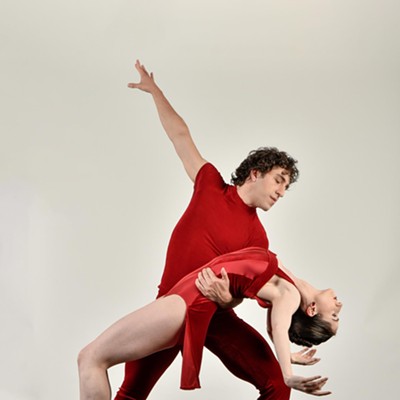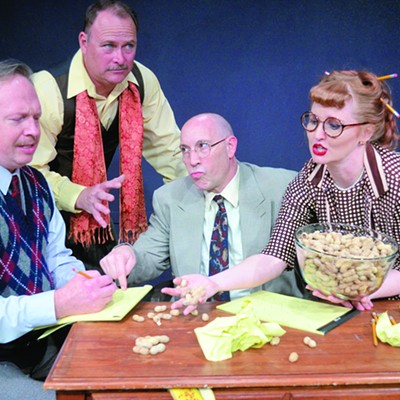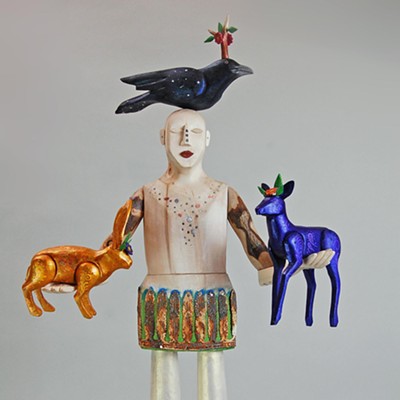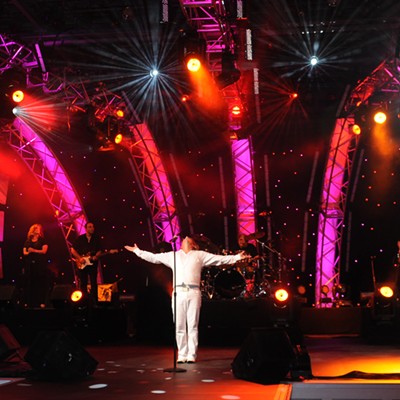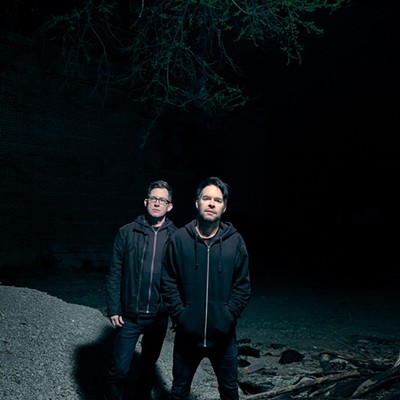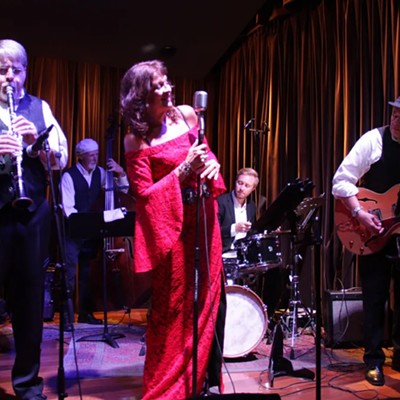The Low Anthem's music is rooted in its members' long friendships, and the deep love they share for history's oldest instrument, the human voice, and its most instinctual arrangement technique, vocal harmonies.
The hauntingly gorgeous ballads for which they are best known—"Charlie Darwin," "To Ohio"—feature acoustic instruments from another era, including clarinet, pump organ and French horn. When they want to make more noise, they use vintage drums.
But the practical aspects of performing in habitually noisy rock clubs are causing these artists (Ben Knox Miller, Jeffrey Prystowsky and Jocie Adams) to change their tune. They've just finished recording a new album that expands their repertoire of noisier songs from the two proto-rockers—"The Horizon Is a Beltway" and "Champion Angel"—on their 2009 release, Oh My God, Charlie Darwin. And they've recently added a fourth member, multi-instrumentalist Mat Davidson, to add extra layers and new sounds to the mix.
Bassist, drummer and percussionist Jeffrey Prystowsky says, "The more we play drums and electric guitar, the more we are forming our own rock 'n' roll style. That strain of the band will continue."
For all the subtlety of their painstakingly crafted sound, The Low Anthem has not yet attained the rapt listening audience their quieter music deserves. Attentive silence is not entirely foreign to rock-club settings; many solo acoustic acts command them. So the response may change as more fans become familiar with The Low Anthem's music. Having signed last year with the Warner imprint Nonesuch, and now on tour with the Avett Brothers, they're discovering that more fans know their songs and willingly slip into the folds of their mood. Meanwhile, though, the band is adding material to crank up the volume in between the slower songs.
"It started for us playing in these noisy bars," Prystowsky says. "We had to find a way to cut through, so we traded in our acoustic guitar and upright bass for electric guitar and drums. And from then on out, we've been slowly adding more and more songs that have a kick to them.
"There's a whole tradition there that we're also tapping into," he says. "We really love early rock 'n' roll, like Chuck Berry's style, Jerry Lee Lewis ... we're really into that. And I'm really into New Orleans grooves, Dr. John and so on. Also, we listen to our contemporaries, like The Slip ... they're friends of ours, and some really great drummers." (Performing as The Barr Brothers, some members of The Slip will open two dates in Canada on The Low Anthem's headlining tour following their opening dates for the Avetts.)
As it ventures into new sonic territory, the band also may abandon the conceptual approach they took to Darwin's lyric themes. The Darwin songs seemed influenced by a philosophical tension between notions of mechanical and scientific determinism, as represented by Darwin's theory of natural selection, and a belief in individual choice and the value of community as represented in John Steinbeck's East of Eden. But when asked what theme the new record ponders, the band has no answer.
That evolution away from philosophical grounding may be another reaction to their rock-club experiences. Early on, they got a reputation for being eggheads, even by indie-rock standards, and no one dislikes being pigeonholed more than The Low Anthem. "Some people kind of pin us as anti-modern things—modern music and modern technology," Prystowsky says, "but it's really more like we're just open to anything. We're not stuck in 2010, and we're not stuck in 1930. We just really love all the history of music, and we have just put together things that seem right to us."
The equipment they've put together is a good example. After some experimentation, they found that vintage drums, including one prize they found at Tucson's Chicago Store, worked the best in revving up their rock sound. But they learned that they needed state-of-the-art microphones to capture the unique qualities of the old drums' sound.
"It's amazing," Prystowsky says. "I didn't know until I started playing a lot more drums that it's really the same as with the other instruments. The older drums are warmer-sounding; they're not like machine-produced. They don't have this standard, inhuman, machine-like precision. A brand-new snare drum, a brand-new drum set and new cymbals—they lack character, you know? We bought this old drum set—a vintage kick drum and snare drum—and they really have a unique, particular sound.
"We also have bought a vintage microphone, but we really like modern microphones, because if you have a vintage instrument, a modern microphone can pick up the vintage character of the sound, so the combination is really beautiful."
The band also has something of a mascot for its expanded use of percussion: "We got some cool cymbals, one of which was given to us by Jay Bellerose, drummer on Raising Sand with Alison Krauss and Robert Plant."
Prystowsky says Tucson fans can expect to hear several new songs from the forthcoming release. Beyond that, he says he just wants to "let the music speak for itself." So far, the music has spoken in warm, human tones; in intense and conflicting emotions, subtly revealed; and, ultimately, in heroic humanism, an insistence on agency in a potentially overwhelming societal and environmental chaos. Let's hope that isn't going to change.


